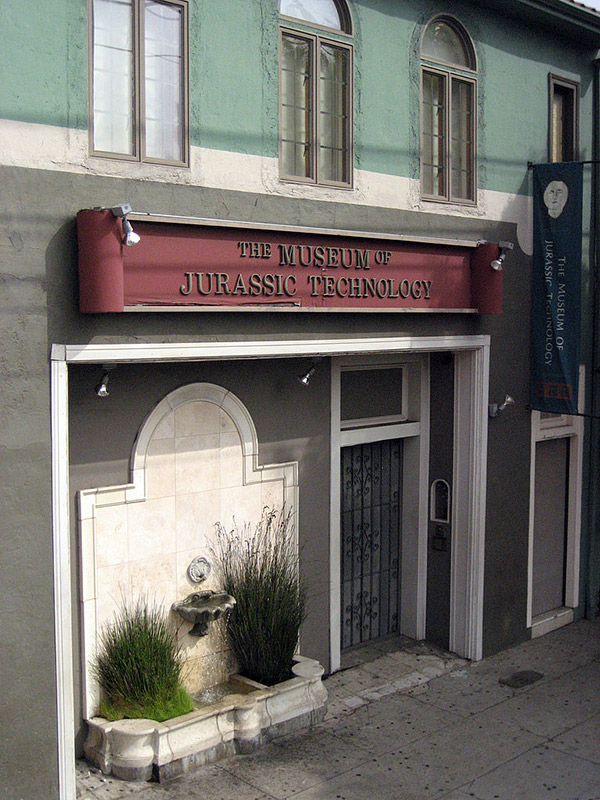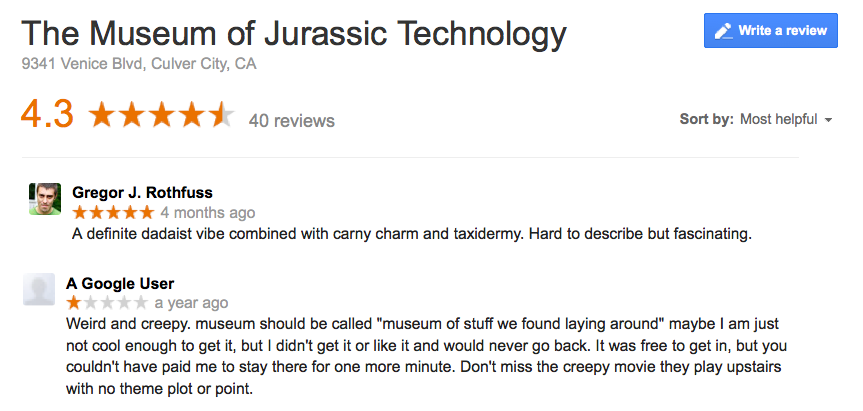Arts writer and Getty graduate intern Sarah Zabrodski recently landed in L.A. via Toronto and NYC and set out to explore the city’s art scene, taking the less-trodden byways first. Today she visits the Museum of Jurassic Technology.

It looks ordinary enough. Behold the MJT storefront on an undistinguished stretch of Venice Blvd., right behind a bus stop. Photo: Jennifer Bastian
The first (and only) explanation people tend to offer about the Museum of Jurassic Technology, aka the MJT, is that it’s “indescribable.” The name is deliberately perplexing, and the official website, besides appearing like a time capsule of the Internet circa 1998, provides few concrete insights. The museum itself is tucked away behind an unassuming facade in Culver City, although the flutter of white canopies on the roof hints at some of the whimsy ahead. Photography is strictly prohibited, meaning visitors leave without any evidence of what lies beyond the entrance doors.
The space inside is infused with a romantic aura. The galleries are darkened, with dim lights illuminating vitrines containing delicately placed objects. Opera music follows you about, while soft monotone voices narrate the exhibits. Recessed spaces contain either meticulous dioramas or black-and-white films chronicling the ethereal histories of the featured people, theories, and events.
The exhibitions are as varied as they are esoteric. Marvel at microminiature sculptures of Pope John Paul II and Donald Duck erected in tiny needle eyes. Puzzle over a magician’s decaying dice. Attempt to wrap your mind around Geoffrey Sonnabend’s opus, “Obliscence: Theories of Forgetting and the Problem of Matter.” Sip tea while listening to live music in the Tula Tea Room. Above all, embrace the creeping sensation that not everything in this museum should be absorbed at face value.

Although the MJT exudes an authoritative tone, the exhibits subtly yet strenuously push the limits of belief. Fact and fiction lose their distinction and blend into one befuddled state. The husband-and-wife founders of the MJT, David Hildebrand Wilson and Diana Drake Wilson, would probably liken this state to a feeling of wonder.
Take for example, “The Micromosaics of Henry ‘Harold’ Dalton.” A series of microscopes offer zoomed-in visions of teensy-tiny decorative floral designs, each one composed of even tinier colorful pieces of some shimmering material.
The wall text, in a manner typical of the MJT, is long, dense, and filled with seemingly arcane information. My first pause arrives when I read that the field of micoscopy enjoyed “modest popularity among lay public” in 1829. 1829? That seems awfully early for the general public to have enjoyed such technological pursuits. Reading on, I learn that Dalton made these mosaics from “diatoms and scales from butterfly wings.” Scales from butterfly wings, really? And what are diatoms? Wikipedia describes them as “a major group of algae…among the most common types of phytoplankton.” Can all this possibly be true?

The website does not clarify matters
The gift shop doesn’t alleviate this confounded feeling. The presence of authentic-looking books dedicated to many of the museum’s most questionable exhibition subjects lends an aura of legitimization to their existence. Yet each book is published under the dubiously named Society for the Diffusion of Useful Knowledge.
In the age of Google, everything seems verifiable, but the MJT thwarts even the most avid of researchers in sorting the real from the imagined. Internet searches inevitably lead back to the same source, the MJT itself. Lawrence Weschler (a onetime Getty scholar) wrote an entire book, Mr. Wilson’s Cabinet of Wonder: Pronged Ants, Horned Humans, Mice on Toast, and Other Marvels of Jurassic Technology, about his quest to navigate this enigmatic environment and locate solid ground. He never finds the right footing, but notes that the MJT “infects its visitors with doubts—little curlicues of misgiving—that proceed to infest all [their] other dealings with the Culturally Sacrosanct.” (p. 40)
Indeed, I tend to approach museum settings without any real skepticism. I might question a particular interpretation, but I’m unlikely to cast doubt on the hard “facts.” If the wall label says it, it must be true. The MJT exposes this blithe acceptance and turns it on its head.
Therein lies the allure of the MJT. It strikes a virtuosic balance between the facts and the fictions, making us doubt both in equal measure. It’s strangely impossible to definitively decide if anything is true or false. Instead we must deftly walk the tightrope of suspended disbelief. The takeaway message is surprisingly clear: question everything and revel in the murky territory, the place of wonder.

Photos don’t capture the experience of the MJT. Moreover, they’re forbidden.
The Getty Gadabout: A Peek at Art Locales in L.A. is an occasional series spotlighting intriguing places to see art in Los Angeles.




Great article Sarah, I am intrigued.